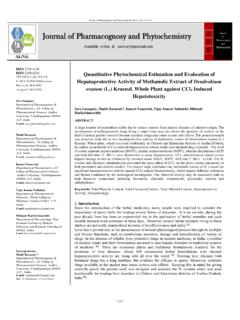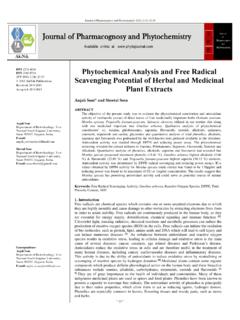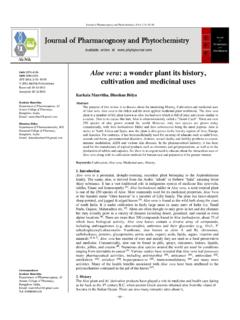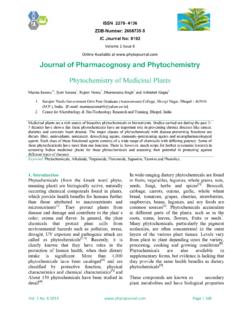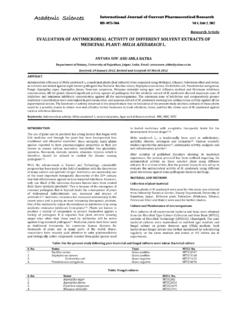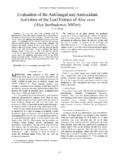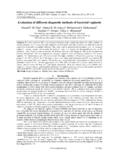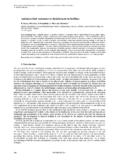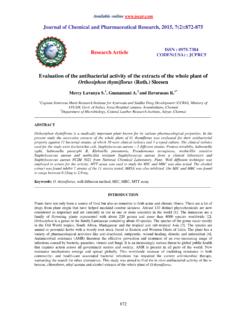Transcription of P-ISSN: Antimicrobial activity and minimum …
1 ~ 298 ~ Journal of Pharmacognosy and Phytochemistry 2017; 6(3): 298-303 E-ISSN: 2278-4136 P-ISSN: 2349-8234 JPP 2017; 6(3): 298-303 Received: 21-03-2017 Accepted: 22-04-2017 Hagir Omer Musa Abakar Al-Neelain University, Faculty of Science and Technology, Department of Chemistry, Khartoum, Sudan Shami EA Bakhiet Al-Neelain University, Faculty of Science and Technology, Department of Microbiology and Molecular Biology, Khartoum, Sudan Ragaa Satti M Abadi Al-Neelain University, Faculty of Science and Technology, Department of Chemistry, Khartoum, Sudan Correspondence Hagir Omer Musa Abakar Al-Neelain University, Faculty of Science and Technology, Department of Chemistry, Khartoum, Sudan Antimicrobial activity and minimum inhibitory concentration of Aloe vera sap and leaves using different extracts Hagir Omer Musa Abakar, Shami EA Bakhiet and Ragaa Satti M Abadi Abstract Many of the health benefits associated with Aloe vera have been attributed to the polysaccharides contained in the sap of the leaves.
2 The main objectives of this study is to evaluate the Antimicrobial activity for both sap and leaves extracts of A. vera using different extraction methods. Aloe vera sap and leaves extracts were investigated using agar-well diffusion technique with different concentrations. Both types of extract revealed Antimicrobial inhibitory effect ranged from pronounced, intermediate, and low. The sap extract showed more effective than the leaves extract against all test microorganisms. The highest mean diameter of zone (MDIZ) showed with sap water extract (100 g/ml) against Pseudomonas aeruginosa and Bacillus subtilis (47 mm). While the lowest one showed with sap and leaves saponins (100 g/ml) against all test microorganisms (12 14 mm) with exception of Pseudomonas aeruginosa, Bacillus subtilis and Staphylococcus aureus whom showed resist ( mm). The minimum inhibitory concentration (MIC) showed g/ml for almost all test microorganisms and different types of extracts except acetone extract from leaves which exhibited MIC 50 g/ml.
3 The present study concludes that the A. vera sap and leaves could be used as medicinal plant with further investigation to determine its toxicity and side effects if any. Keywords: Aloe vera, Antimicrobial activity , sap, leaves, minimum inhibitory concentration Introduction Aloe vera (L.) (Aloe barbadensis Miller) is a perennial succulent xerophyte, which develops water storage tissue in the leaves to survive in dry areas of low or erratic rainfall [1]. Commonly referred to as Aloe vera, is one of more than 400 species of Aloe belonging to family Liliaceae [2]. The species does not have any naturally occurring populations, although closely related aloes do occur in Northern Africa [3]. It is a cactus-like plant that grows readily in hot, dry climates and currently because of demand; it is cultivated in large quantities [4]. Aloe vera plant almost sessile perennial herb, has leaves 30-35cmm long and 10cm broad at the base, colour pea-green (when young), bright yellow tubular flowers 25-35cm in length arranged in a slender loose spike, stamens frequently projected beyond the perianth tube [5].
4 Plant extracts represent a continuous effort to find new compound against pathogens. Approximately 20 g/ml of the plants found in the world have been submitted to pharmacological or biological test, and a substantial number of new antibiotics introduced on the market are obtained from natural or semi synthetic resources [6]. The skin plays an important role in protection from the body internal environment and it is the largest organ in human s body so exertion of serious damage to this organ may cause several problems in its survival [7]. Medicinal plants according to the World Health Organization (WHO) defines them as herbal preparations made by introducing plant materials to extraction, fractionation, purification, concentration, or other physical or biological processes, which may be produced as a basis for herbal products or for immediate consumption [8]. Aloe vera has modified thick fleshy leaves, it not only has cell wall carbohydrates such as cellulose and hemicellulose but also storage carbohydrates such as acetylated mannans the polysaccharides found in the inner leaves parenchymatous tissue have medicinal importance and also the biological activities are due to presence of large number of compounds [9].
5 The herb is used internally to combat most digestive problems, including constipation, poor appetite, colitis, irritable bowel syndrome as well as, asthma, diabetes, immune system enhancement, peptic ulcers. Aloe is used externally for the treatment of skin irritation, burns, scalds, sunburn wounds, eczema, psoriasis, acne, dermatitis, ulcers, to stimulate cell regeneration. The plant is also used in the treatment of healing properties, effects on skin exposure to UV and gamma radiation, anti-inflammatory, antiviral and antitumor, moisturizing, anti-aging effect, antiseptic, enhance immune system, ~ 299 ~ Journal of Pharmacognosy and Phytochemistry hypoglycemic, cytotoxic, and anti-diabetic effects, antibacterial effect, antioxidant, cardiovascular effect [10]. Its juice may help some people with ulcerative colitis, an inflammatory bowel disease [11]. The main objectives of this study is to evaluate the Antimicrobial activity for both sap and leaves extracts of A.
6 Vera using different chemical extractors. Materials and Methods Chemicals Acetone Methanol n-Butanol Ethanol Acetic acid Sodium chloride Calcium hydroxide Ammonium hydroxide Hydrochloric acid Diethyl ether Methods Aloe vera chemical components were extracted according to the Harborne [12]. Preparation of methanol extract from leaves An amount of 15g of dried powdered A. vera leaves were placed into 300cm conical flask, 100cm of 80 g/ml methanol were added. The conical flask was stoppered. The mixture was filtered after two days and the marc was watched with more solvent and the volume was adjusted to 150 cm with 80 g/ml ethanol. Preparation of methanol extracts from sap Six hundred (600) ml of sap were dried in oven (60-80 C) and the dried sap was weighed. An amount of 5 g of dried powdered sap were placed into 500 ml beaker and 100 ml of 80 g/ml ethanol were added and allowed to stand to 2 days the mixture, was filtered and the marc was watched with more solvent and volume was adjusted to 150 cm with 80 g/ml methanol.
7 Preparation of water extract from leaves An amount of 15g of dried powdered A. vera leaves were placed into 300cm conical flask 100cm of distilled water were added. 1ml of 10 g/ml acetic acid was added. The conical flask was stoppered and after two days the mixture was filtered and the marc was watched with more distilled water, the volume was adjusted to 150 cm with distilled water. Preparation of water extract from sap Six hundred (600) ml of sap were dried in oven (60-80 C) and the dried sap was weighed. An amount of 5 g of dried powdered sap were placed into 600 ml beaker and 100 ml distilled water were added and 1ml of 10 g/ml acetic acid was added and allowed to stand to 2 days, the mixture was filtered and the marc was watched with more solvent and the volume was adjusted to 150 cm with distilled water. Preparation of acetone extracts from leaves and sap An amount of 10gms of sample were placed into 300cm beaker and 100 ml of acetone were added the mixture was stirred to 4 hrs.
8 The extract was filtered and dried. Alkaloid determination An amount of 5gms of the plant sample were placed into a 250ml beaker. 10 g/ml acetic acid in ethanol were added, the mixture was covered and allowed to stand for 4hrs. The extract was filtered and concentrated on a water bath to one quarter of the original volume. Concentrated ammonium hydroxide was added drop-wise to the extract until the precipitation was complete. The whole solution was allowed to settle and the precipitate was collected and washed with diluted ammonium hydroxide and then filtered the residual alkaloid was dried and weighed. Saponin determination An amount of 10gms of plant sample were put into a conical flask and 50ml of 20 g/ml aqueous ethanol solution were added. The sample was heated over a hot water-bath for 4hrs with continuous stirring at about 55. The mixture was filtered and the residue re-extract with another 200 ml of 20 g/ml ethanol.
9 The combined extracts were reduced to 40ml over water-bath about 90 C. The concentrate was transferred into a 250ml reparatory funnel and 20ml of diethyl ether were added and shaken vigorously. The aqueous layer was recovered while the ether layer was discarded. The purification process was repeated. 60ml of n-butanol were added and the combined n-butanol extracts were washed twice with 10ml of 5 g/ml aqueous sodium chloride. The remaining solution was heated in water-bath. After evaporation, the sample was dried in the oven to a constant weight and the saponin content was calculated as percentage. Flavonoid determination An amount of 10gms of the plant sample was extracted repeatedly with 100ml of 80 g/ml aqueous methanol at room temp. The whole solution was filtered through whatmman filter paper No 42 (125mm). The filtrate was later transferred into a crucible and evaporated to dryness over water-bath and weighted to constant weight and the flavonoid content was calculated as percentage.
10 Acids determination An amount of 5gms of dried sample were boiled for 30 minutes with 20 ml of distilled water. The mixture was cooled and filtered. The previous step was repeated twice using different solvents as mixture of distilled water and ethanol (1:1) and ethanol. The pH of above solutions was measured (water extract , alcohol extract , alcohol: water extract ). The aqueous extract was neutralized at room temperature with suspension of calcium hydroxide giving yellow precipitate in sap and gray with leaves. Then filtered and dried the weight was recorded. Preparation of the test microorganisms Standard microorganisms The microorganisms used in the present study were kindly provided by scientists at Khartoum National Health Laboratory and designated as follows: Standard microorganisms Bacterial organisms Code number Escherichia coli ATCC/25923 Pseudomonas aeruginosa ATCC/27853 Bacillus subtilis NCTC/8236 Staphylococcus aureus ATCC/25923 Candida albicans ATCC/7596 Aspergillus niger ATCC/9763 * American Type Culture Collection (ATCC) Rockville, Maryland, USA.

